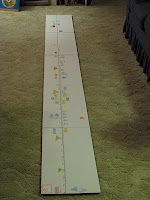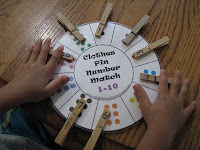One of the shortcomings of the traditional school setting? Kids may be forced to read, write, or do math before their brains are ready for it. With the ever-increasing emphasis on standardized testing, this has become even more of a problem than it once was. Several weeks ago, I was working in a rather large (okay, HUGE) public school setting and a curriculum specialist said, "Today's kids are taught at a [curriculum/content] level about one year ahead of where their parents were at the same age. In order to catch up with the rest of the world, we need to move ahead ANOTHER year." [So today's kids should be learning content that is a full two years ahead of the age their parents learned the same content.]
No pressure.
It's just that education dollars depend on achieving those goals.
I digress...
Because I've actually been thinking about a child much closer to home. Or, IN my home. My own ds.
He arrived home from China at the age of 3, fluent in Mandarin and Cantonese. Now, just a year-and-a-half later, he is fluent in English. I've been continually amazed at his ability to learn.
But I'm also a little confused. I don't quite know how to assess his developmental level. His fine motor skills have been amazing since the day we met; he can color very precisely and cut like an average kindergarten. His large motor skills have done a 360. When he arrived home, he couldn't run without falling. He sorta ran with half his body. Within a few months (with continual running and LOTS of falling), this had completely changed. He now runs and runs and runs; you'd never know there was any problem. (Side note: he didn't have any special need that affected the ability to run...I'm guessing that he didn't have large motor skills because he didn't have space to develop them. I don't think he ran in big open spaces.)
But we have gaps. Printing is one. He can make a few letters, but for letters that take multiple steps (like making a small "b" where you have to draw a straight line and then go up over the line and make a circle that's connected) he just cannot do it. If I take his hand and make the motion over and over and over, he cannot replicate it when I remove my hand.
Frankly, I wouldn't care at all except he wants to do it. He is constantly asking to do school and as part of school, he wants to write.
So, as Providence would have it, a friend emailed me today, asking for a copy of an article I recently sent out. I read it and ****BING, BING**** all my "duh, yeah, that sounds familiar" alarms went off. Here's an excerpt:
Teaching Our Children to Read, Write, and Spell
by Susan R. Johnson MD, FAAP, 5/7/2007
Part I— The Proprioceptive System
There is a widely-held belief that if we just start teaching children to write, read, and spell in preschool, they will become better writers, readers, and spellers by the time they reach the first and second grades. This is, however, not true. The truth is that children only should be taught to write, read, and spell when their neurological pathways for writing, reading, and spelling have fully formed. There are many neuropsychologists, developmental specialists, occupational therapists and teachers who are concerned that our current trend in this country of pushing “academics” in preschool and kindergarden will result in even greater increases in the number of children, particularly boys, diagnosed with attentional problems and visual processing types of learning disabilities.
In order for children to be able to sit still, pay attention, and remember abstract shapes, like letters and numbers, they first need to have developed their proprioceptive system. In my clinical practice I see children who are being asked to sit still at a desk who can’t yet “feel” where they are in space. They have to keep their muscles and body moving all the time or sit on their feet or wrap their feet around the legs of their chair in order for their mind to locate the position of their body. They also have difficulty balancing on one foot while their eyes are closed. Their drawing of a person is more like that of a younger child, being stick-like in form and lacking hands and feet. These children are often given the label of Attention Deficit Disorder because they appear fidgety in their movements, have difficulty paying attention, and have poorly developed fine-motor skills.
Read the entire article here.
I doubt that this will surprise anyone, but I didn't learn anything about this type of stuff in college. In education. I've learned loads about it as a parent. Necessity,...the MOTHER of invention...
And, to go along with this thought train, we have many, many children (and adults, for that matter!) running around with incomplete neuro pathways. Or neurological "glitches." The glitches cause all kinds of symptoms, ranging from ADHD looking behaviors to reading problems to difficulties with math to eye tracking issues... A
huge list can be found here. (I've also quoted it at the bottom of the page. I have permission.) While that link is directed toward adoptive families, there are many, many reasons that a child (or adult) may have a neuro glitch.
Fortunately, there are a lot of things you can do about "glitches." Unfortunately, the majority of educators (myself included until I self-educated) are not trained in what to do about them. I'll post more about the "what to do" later...
But, back to my son...
Developmentally, he simply isn't ready for some learning experiences that other kids his age are ready for. I think the day will come; however, if he gets more frustrated because he wants to do some things and can't, I will probably need to become more deliberate in the opportunities I give him to strengthen certain areas of his brain.
Thanks for letting me ramble. I had to clear a neuro pathway! ;)
Signs of Neurological "Glitch" or Dysfunction at three different brain levels:
Pons Dysfunction:
* Skips words or parts of words while reading
* Uses finger to track text across the page
* Gets seriously hurt and makes little to no fuss, such as the baby who teeths without getting fussy
* Constantly hungry, even if he has just eaten an adequate amount of food
* Little or no appetite
* Lack of empathy
* Self-abuse, such as picking at scabs, biting fingernails until they bleed, and other forms of extreme self-stimulation
* Picks on others, including animals
* Bed wetting (beyond what is age appropriate)
* Fight or flight response to inappropriate situations, such as acting as if her life is threatened when a small issue has occurred. (Example: child trips on a toy, gets angry, and blames it on the closest available person)
* Fool-hardy risk-taking, such as leaping off of high structures or diving off of furniture
* Overly affectionate with strangers
* Inappropriate perception of danger
* Night terrors
* Violent rages
* Anxiety
* Clingy
* Controlling
* Manipulative
* Superficially charming
* Creates chaos in her environment
* Difficulty bonding with parents, siblings, and other caregivers
* Avoidance of eye contact
* A profound sense of displacement, isolation, and mistrust, with statements such as, “You don’t love me,” “I shouldn’t be alive,” etc.
* Pigeon-toed
* Hunched shoulders
* Anterior head carriage (head juts forward)
* Midbrain-level and cortical dysfunction, as neurology is cumulative
Midbrain-level Dysfunction:
* Difficulty tracking text down a page while reading or doing math
* Difficulty with reading comprehension; unable to remember or recall a story
* Depth perception issues, including seeing blurry or double
* Distractibility; every little thing catches her attention
* Hyperactivity; she can’t sit still even for a moment
* Short attention span
* Trouble remembering and following through on tasks. If told to do three tasks in a row, cannot complete all three of them with prompts or reminders.
* Difficulty responding to prompts when engrossed in a task. If doing something he is interested in, one has to be right in his face to get his attention.
* Difficulty reading non-verbal social cues. For example, asks people if they are feeling happy or sad, rather than reading their emotion.
* Out-of-sync in social settings. Can’t seem to follow what is discussed or shared.
* Clumsiness
* Feet point outward
* Difficulty maintaining balance
* Muscles that are too loose or too tight, such as the person who is extremely double-jointed and limber.
* Inappropriate spatial boundaries; is in your face or hangs way back
* Says “yes” to every obligation, even when already over-extended
* Impulse control issues. Will do something that she has been repeatedly instructed not to do and, when asked, says, “I didn’t know” or “I forgot.”
* Immense frustration, generally resulting in outbursts
* Reversal of letters and/or numbers
* Rages that are seemingly out-of-nowhere
* Inarticulate, atonal, or slurred speech
* Difficulty accessing words
* Auditory processing issues
* Disrupted or inconsistent sleep patterns
* Heartburn or stomachaches
* Bladder and/or bowel issues, such as constipation and irritable bowel syndrome
* Sensitivity to textures of food or difficulty chewing
* Poor temperature regulation, as in the person who never wants to wear a coat even when in a cold environment
* Sensitivity to textures of clothes or clothing tags
* Verbal and/or physical tics, such as a rapid eye blinking or repitition of the same word or phrase
* Drama queen
* Neurochemical imbalance
* Depression
* Bipolar disorder
* Autism spectrum disorders
* Obsessive compulsive disorder
* Allergies
* Autoimmune disorders
Cortical Dysfunction:
* Difficulty recognizing symbols, such as letters and numbers
* Immature language skills, such as the use of incomplete sentences, incorrect pronouns, or difficulty expressing needs
* Difficulty walking and running
* Poor fine motor skills
* Difficulty sequencing information, especially in abstract situations
* Memory problems































